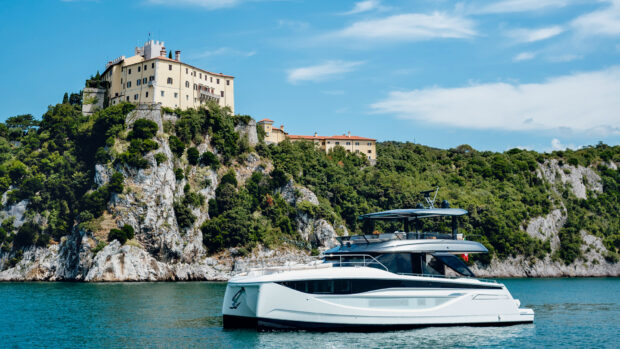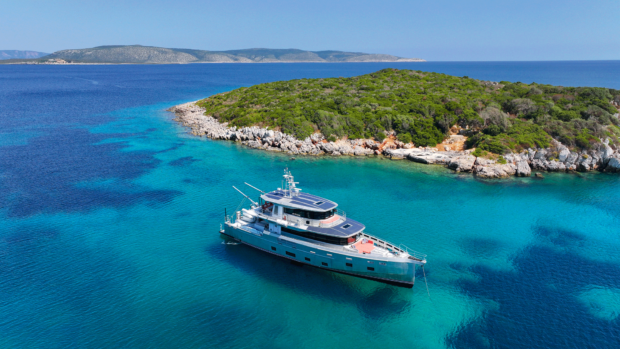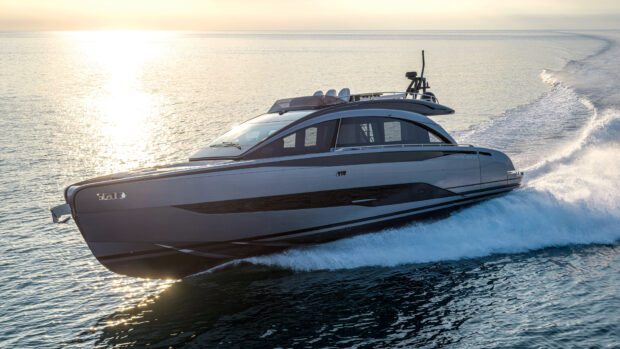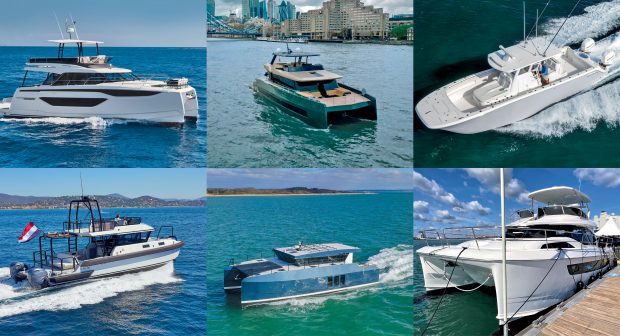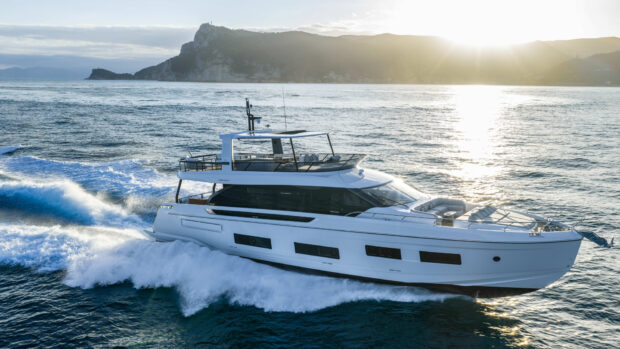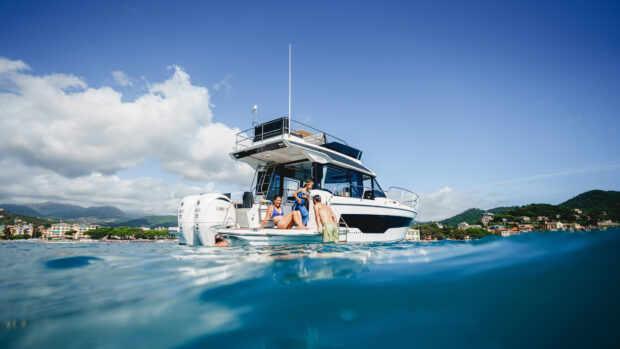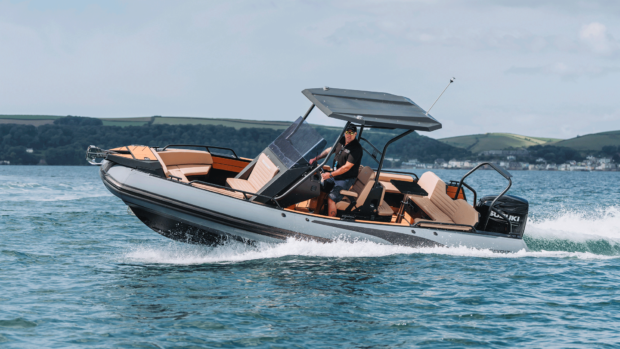The Arksen 85 Explorer is an excellent long-range cruiser, built from recycled aluminium and engineered for remote waters.
Arksen is not your typical boat builder. Look on its website and you’ll find it sells everything from £160 technical T-shirts to blinged-up Land Rovers and climbing expeditions to Everest. The only thing unifying them all is a thirst for adventure. Boats are a big part of that, and a personal passion of Arksen’s tech entrepreneur founder, Jasper Smith, but more as a means of delivering the ultimate off-grid adventure than as the end goal itself.
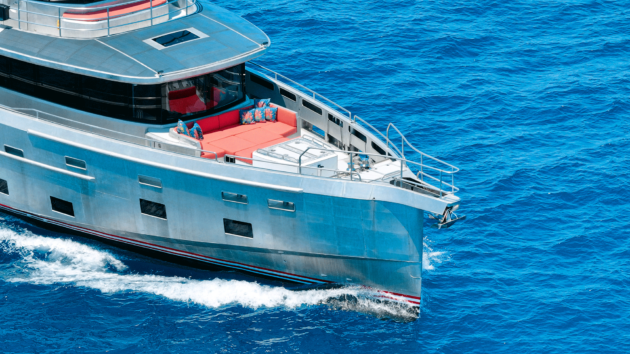
Redesigned as a more luxurious trans-oceanic motor yacht, it’s claimed to be the ultimate long-range explorer
None more so than this 85 Explorer, its flagship model and the foundations on which the entire brand was built. Inspired by the legendary aluminium FPBs pioneered by Steve and Linda Dashew but reimagined by Arksen and redesigned by Humphreys Yacht Design as a more luxurious but no less capable trans-oceanic motor yacht, it is claimed to be the ‘ultimate long-range explorer’.
Full Metal Jacket
The build specification certainly goes some way to backing up that claim. Constructed from 70% recycled aluminium (20mm thick on the keel, 12mm below the waterline and 8mm above) by the Wight Shipyard on the Isle of Wight, its build has more in common with high speed ferries and military patrol craft than a traditional GRP leisure yacht. Robust enough to cruise through ice floes and with sufficient positive buoyancy to recover from a knockdown, it goes well beyond the normal requirements for a Category A RCD rating.
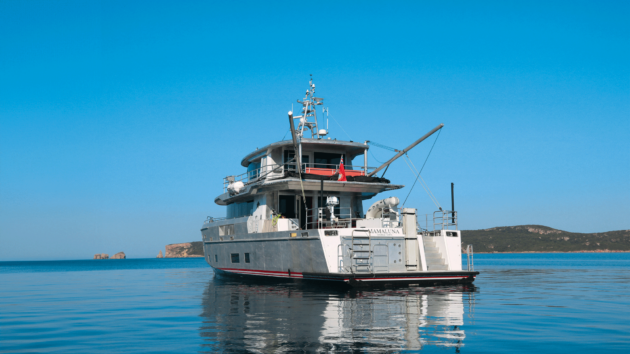
If you value adventure over the trappings of luxury, there is little else that can match it
The superstructure windows, for example, are 25mm thick so they can withstand a direct hit from a wave; the vault-like external doors are clamped shut with multiple lugs to keep them airtight; even the lower deck accommodation is divided into three watertight compartments in case the hull itself is breached.
The commercial grade engineering reinforces that air of impregnability. Everything is designed with double or triple redundancy in mind. The fuel, all 17,500 litres of it, is spread across four bunker tanks and two day tanks to maintain maximum control over boat trim and fuel condition. Every drop of it passes through three different filtration systems before it reaches the engines, all of which are doubled up so one can be cleaned while the other is in use. Two electric pumps and one manual one ensure there is always a means of transferring it, even if the electrics fail.
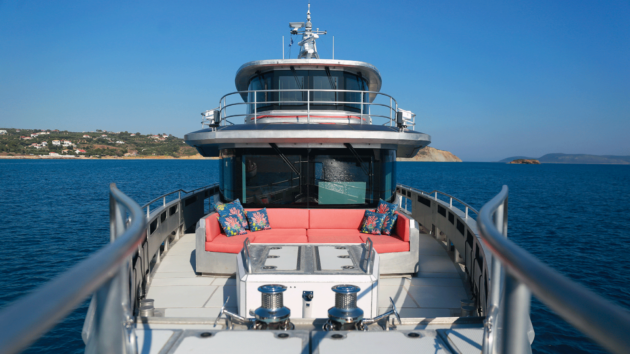
Explorer styling and bare aluminium finish are all part of its robust, no-nonsense appeal
It’s much the same story with the water tanks and desalinators, the over-engineered cooling system and the power generation (40kWh of LiFePO batteries, 2 x 25kVa generators, high capacity engine alternators and solar panels). There’s also a full sewage treatment plant that discharges nothing but clean water, storing the compacted solids until they can be safely removed. All of these systems can be controlled and monitored from the ship’s MFD touchscreens or via manual switches, valves and pumps.
Even the rudders can be steered by a handheld tiller if necessary. It’s impressive stuff, most of which we have seen or heard about before, but how well does it all work in practice and what does it feel like at sea? These were the questions we really wanted answers to and now finally we’re getting a chance to find out for ourselves with a full sea trial.
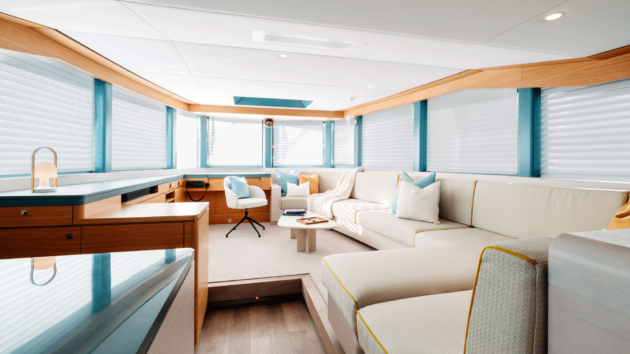
Practical considerations take precedence over sprawling sofas & designer tables
Keep it Simple
We catch up with the boat in Pylos, Greece, where its owner has been busy putting it through its paces as a family cruising yacht before undertaking more serious adventures when time and business interests allow. He’s owned everything from Ferrettis to Flemings before and still owns a Botnia Targa that he collected from Finland and motored down to Greece himself, so it’s fair to say he knows a thing or two about serious cruising boats. Needless to say, he’s delighted with his latest purchase.
Even coming alongside in the 5.5m Highfield tender gives an insight into the Arksen’s character. Rather than being hauled out by a hydraulic platform or crane, it’s lifted onto the aft deck using a simple rope pulley system powered by one of the stern winches. It’s quick, reliable and there’s a manual override if all else fails. It’s the same story elsewhere.
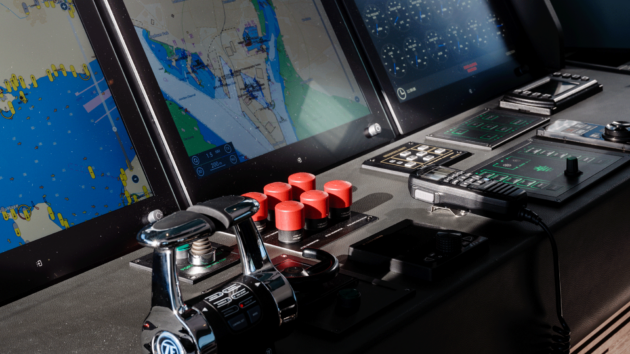
Tiny helm wheel and commercial spec radar share much in common with a ship
There are no teak decks to scrub, no painted surfaces to scratch and no stainless steel rails to polish. The welded joints are left on show as a badge of pride and the aluminium is untreated so the surface layer oxidises creating a natural barrier against corrosion. If you want, you can have all the welds polished out and the topsides fared and painted, but that’s not really the point of a yacht like this. It may look spartan on the outside, but it certainly doesn’t feel that way on the inside.
Opening the exterior cockpit door takes some effort but stepping through is like entering another world. A second sliding inner door acts as an air lock, so the climate-controlled main deck saloon stays at the perfect temperature in both arctic and tropical waters. There’s also a day heads and a heated hanging locker here so you can strip off your wet weather gear before entering the inner sanctum.
Article continues below…
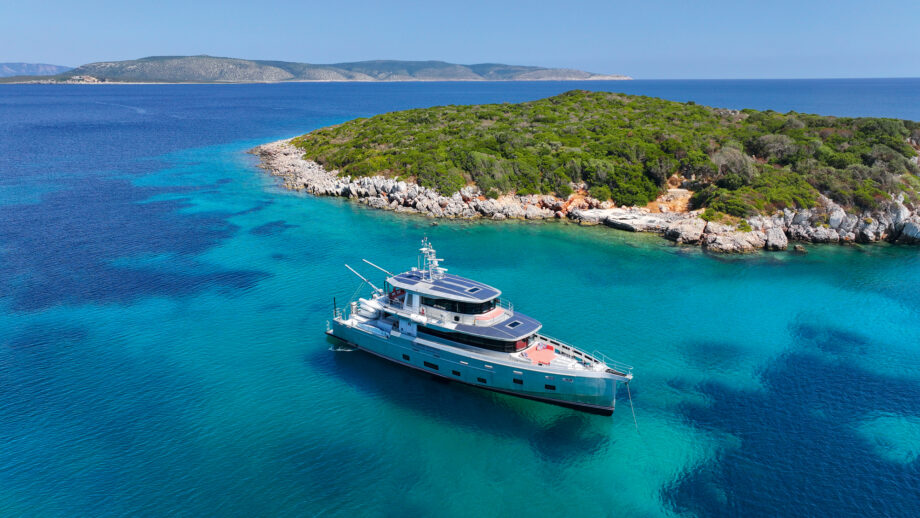
WATCH: Ultimate Ocean Explorer Test – Arksen 85 Sea Trial

Arksen 30 sea trial review: Flat out in the new Range Rover of the sea
Inner peace
Once inside the main saloon, two things strike you. The first is the view. With no bulkheads or deck level changes to interrupt the sightlines, you can enjoy the full panorama of your surroundings through that long sweep of shatterproof windows.
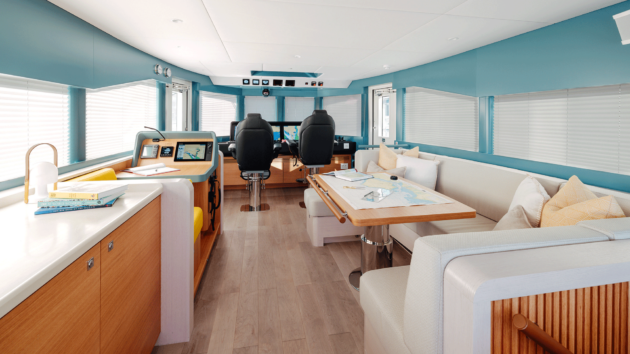
The upper deck houses the main helm and a separate navigation station
The second is the noise, or rather the lack of it. It is, to all intents and purposes, silent. At 6 knots our sound gear registered a barely perceptible 51 decibels, roughly equivalent to the hum of a fridge – impressive stuff but not nearly as impressive as the fact that it barely budged from that figure all the way through the rev range. Even flat out at 1800rpm (the heavy duty 9.3-litre five cylinder Scania engines are designed for constant low-speed running) it was still only 53dB(a).
In 20 years of testing, I have never experienced a quieter motor yacht. You are still aware that the engines are running because at certain revs you can feel a slight resonance through the structure, but this can easily be dialled out by slightly increasing or decreasing the revs. It’s also an extremely comfortable boat to spend time on. That long, slender hull has a very easy motion that allows it to cut through waves with minimal disturbance of the water or its guests.
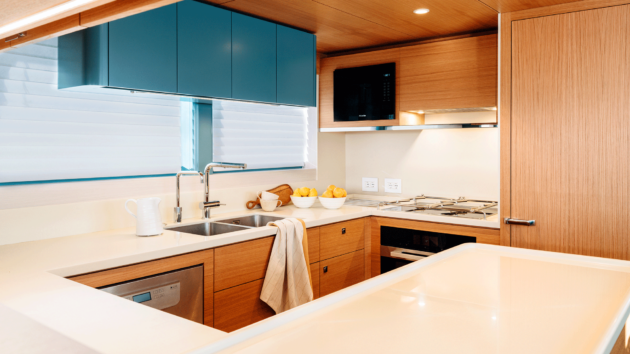
Large, commercial-spec galley is designed to be used underway rather than only at anchor
Admittedly the maximum 2-3ft seas we encountered provided no great challenge for a yacht of this size but the lack of pitching in head seas was notable and the Humphree electric fin stabilisers were more than capable of dialling out any roll when cruising beam-on to the waves. Switching them off did elicit a bit more roll but nothing that would concern us in the event of an electrical failure.
Putting the waves on our stern quarter did reveal one chink in its armour but only because the autopilot struggled to maintain a constant heading due to the surfing effect of the quartering swell, leading to a slight corkscrewing motion. Steering it by hand is no better because the tiny electronic helm wheel has no real feeling or feedback to it.
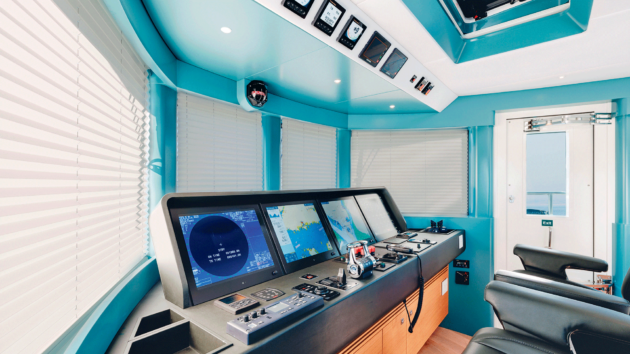
Doors on both sides of the bridge give quick access to the outer wing stations
The curved flowline rudders, shaped to suit the exact wash of the big slow-turning propellers, are hugely effective but as with any boat this size, take time to have any effect. Once they do, it will turn surprisingly quickly, completing a full 360 within a couple of boat lengths.
Helming quirks
The other unusual characteristic of the Arksen 85 is the way it leans out during a turn. Once again, the fin stabilisers do a good job of reining this in, but anyone used to the way a planing boat leans into a turn, providing a natural counterbalance to the G-Force pushing you out, will find it mildly disconcerting to be leaning the wrong way for a second or two before the fins level things up again.
The throttles are equally devoid of drama, largely because you can barely discern any difference between the engines’ idling speed of 750rpm and max revs of 1800rpm. If it weren’t for the needles steadily inching their way around the virtual dials or the gradual increase in knots, you’d question whether they were actually working.
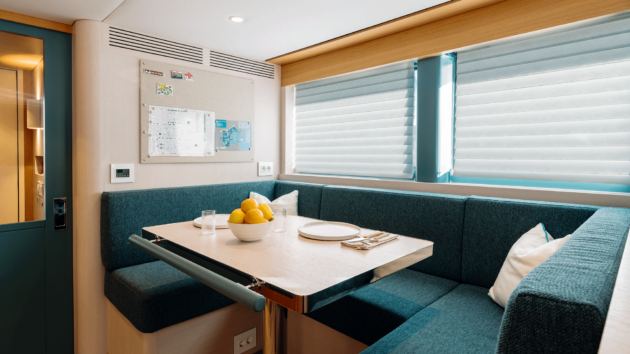
The dinette is amidships to minimise any pitching motion
Admittedly, this is not a quick boat, maxing out at 13.6 knots on test but you’d be surprised how much ground you can cover when it’s quiet and comfortable enough to cruise all day and all night without disturbing your guests. The real benefit of that LDL hull design (low displacement to length) is its efficiency. The combination of a slender frontal area with a long waterline length and a shallow stern allows the water to flow very cleanly around and under it.
Most boats of this size drag a big wake behind them as the water swirls round to fill the trench ploughed by their deep sterns. The Arksen’s shallow transom, by contrast, barely leaves a furrow on the surface as it slips along. The resulting fuel flow figures we recorded during our sea trial speak for themselves, even after a year at sea protected by Intersleek’s silicone-based fouling release coating rather than a biocide antifouling.
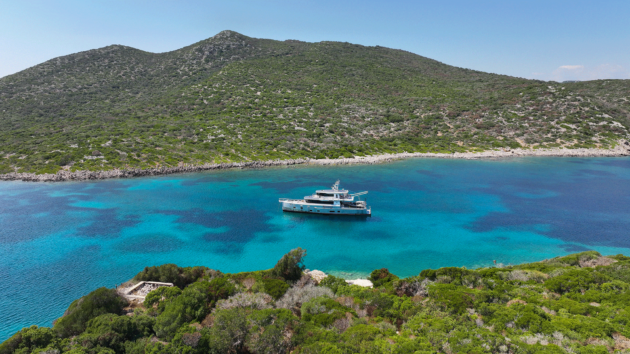
Low displacement to length ratio is key to the 85’s fuel efficiency but the low draft also allows it to sneak into relatively shallow bays
At 6.4 knots and 800rpm, it was burning a miserly 12lph across both engines for a fuel economy figure of 1.88 litres per nm. Lift the revs to 1400rpm for 11.7 knots and it was still only burning 5 litres per nautical mile. To put this in perspective an 82ft Sunseeker Ocean 156 burns around three times as much fuel at both these speeds. It’s not just the reduced financial and environmental cost of burning less fuel that benefits the owners, it’s the extra range it ekes out from its vast 17,500 litre fuel capacity.
Even allowing for a 20% safety margin, this works out at a cruising range of 7,446nm at 6.4 knots or 3,500nm at 11 knots. In theory, at least, this means you could set off from London with full tanks, cruise to New York, turn around and cruise all the way back again without ever having to top up your tanks.
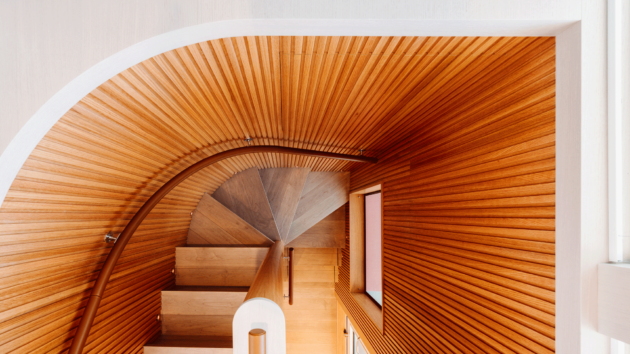
It may be practical but Design Unlimited’s interior is also rather beautiful
Accommodation
While it may look like a slender boat, the Arksen 85 is actually surprisingly beamy; at its widest point is almost as broad as a Sunseeker 90. That creates enough room below deck for what could be a really big full beam owner’s suite with an interconnected office. However, in this instance the owner has partitioned it off as a separate captain’s cabin. Ahead of that the two double guest cabins have their own ensuites and sliding beds that quickly convert to twins.
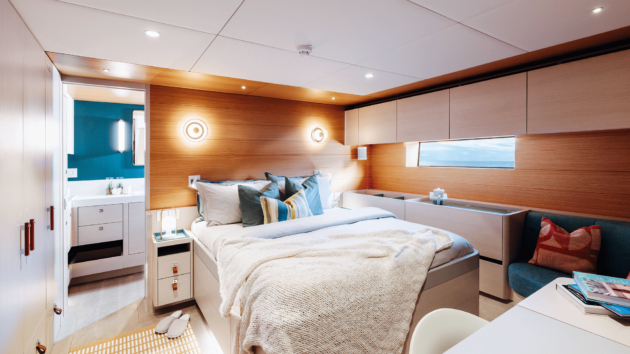
The owner’s cabin prioritises comfort over luxury. It can be extended across the full beam if required
The two smaller bunk cabins in the bow, which can either be used for guests or crew, still have decent sized single mattresses and their own ensuites but the tapering of the hull means everything feels that much tighter. Comfortable and stylish as it is, thanks to Design Unlimited’s carefully curated decor, it deliberately eschews the thick carpets, heavy marbles, glossy surfaces and expensive fabrics that shout luxury but require constant cleaning to keep them looking good.
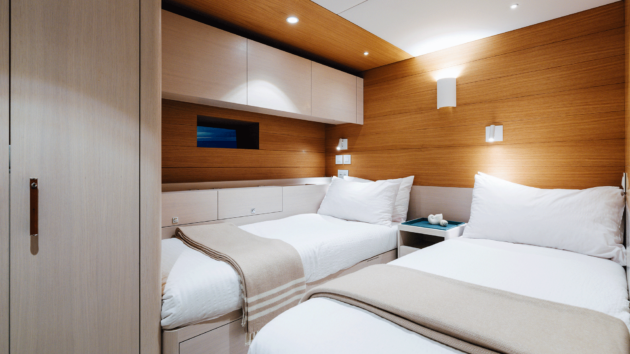
One of the two main guest cabins
The hull windows are small and none of them open, again for maximum structural integrity. It’s a similar story on the main deck where practical considerations like wide, well-protected side decks, a big commercial spec galley and a clever folding lower helm station taking precedence over sprawling sofas, designer dining tables and giant televisions.
What it is, however, is a very sociable layout where guests, owner and crew tend to mingle on more or less equal terms. Even the upper deck with its primary helm station and separate navigation desk is open to the elevated dinette and coffee bar zone. If you’re exploring uncharted areas of the globe, half the fun is being part of the team rather than a mere guest.
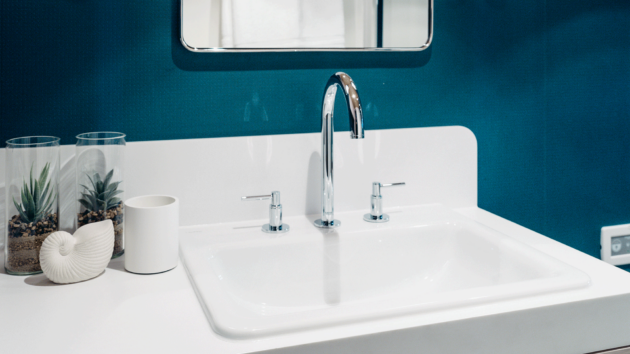
The owner’s ensuite bathroom
 If you enjoyed this….
If you enjoyed this….
Motor Boat & Yachting is the world’s leading magazine for Motoryacht enthusiasts. Every month we have inspirational adventures and practical features to help you realise your sailing dreams, as well as tests and news of all the latest motorboats.
Plus you’ll get our quarterly Custom Yachting supplement where we share the last on offer in the superyacht world and at the luxury end of the market.
Build your knowledge with a subscription delivered to your door. See our latest offers and save at least 30% off the cover price.
Note: We may earn a commission when you buy through links on our site, at no extra cost to you. This doesn’t affect our editorial independence.
Price as reviewed:
£8,500,000.00 As tested, ex. tax
Verdict
With so many different strings to Arksen’s bow, we were concerned that it may start to lose focus on building world class expedition boats. Having now experienced the 85 at sea, we can put those fears to rest. Yes, it would have been nice to sea trial it in more challenging conditions but given that it absolutely delivers on its other core objectives of comfort, refinement, fuel efficiency and reliability, we have no reason to doubt that it would also live up to its heavy weather seakeeping claims. Its pragmatic design and egalitarian layout won’t be to everyone’s taste, but if you value adventure over the trappings of luxury, there is little else that can match it.
Details
LOA: 89ft 7in (27.3m)
Beam: 23ft 0in (6.99m)
Draft: 5ft 0in (1.55m)
Displacement: 82.5 tonnes
Engines: 2 x Scania 350hp
Fuel capacity: 17,500 litres
Water capacity: 6,000 litres
Classification: UK MCA Category 0, Unrestricted
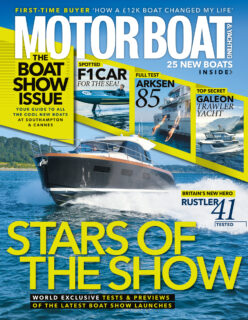

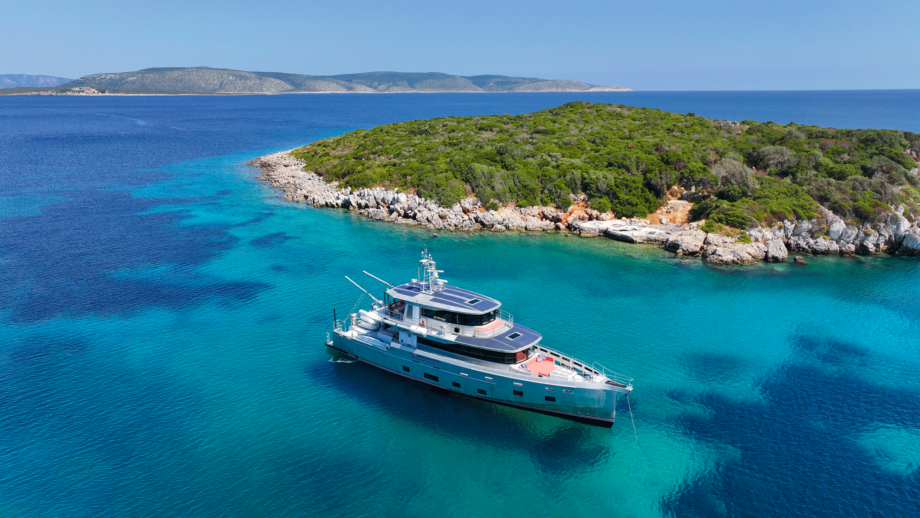
 If you enjoyed this….
If you enjoyed this….